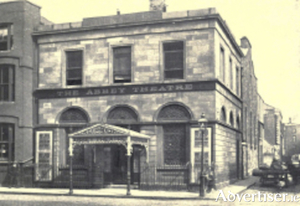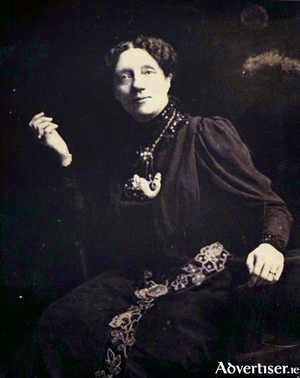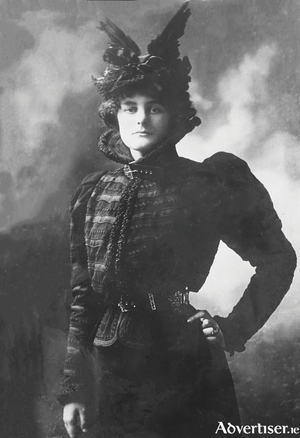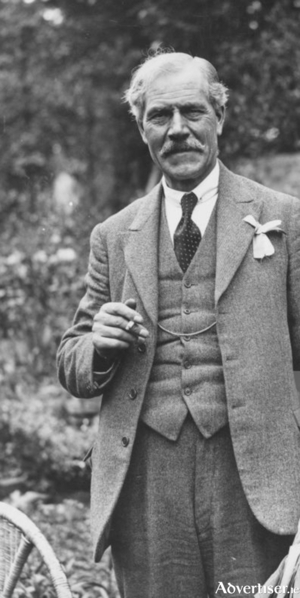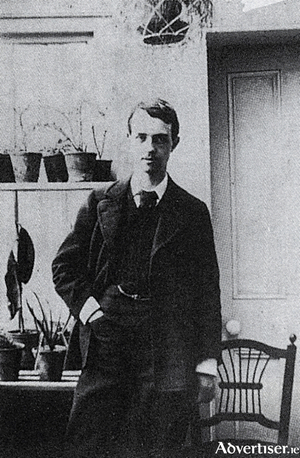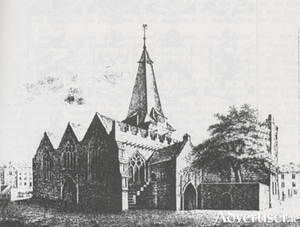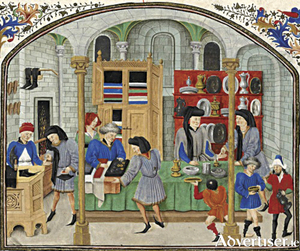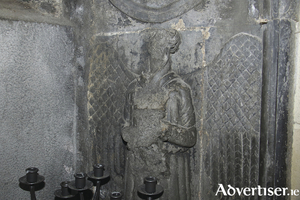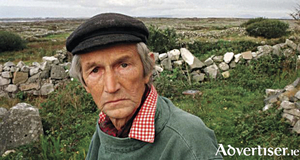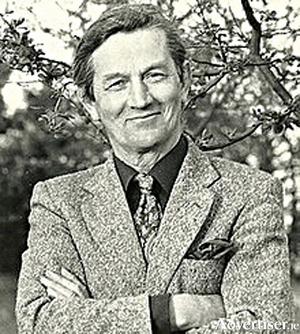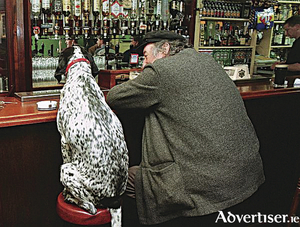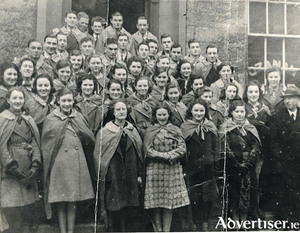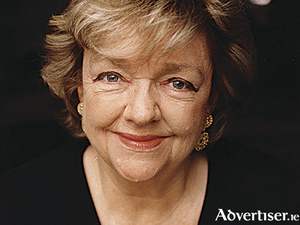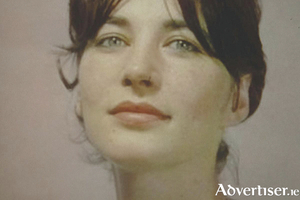Dubliners watched the romancing of WB Yeats with glee
Thu, Apr 30, 2020
The final curtain came down on the relationship between Annie Horniman and the Abbey Theatre in the days following the death of Edward VII on May 6 1910. It was customary that on the death of a British monarch all theatres would close as a mark of respect. Dublin theatres were expected to uphold that tradition, and indeed they did, the only exception on this occasion was the Abbey Theatre.
Read more ...‘You have given me the right to call myself an artist’
Thu, Apr 23, 2020
Not only is it interesting to see the initials of the people Lady Gregory admired on her ‘Hall of Fame’, the famous autograph tree at Coole Park, Co Galway, it is perhaps more interesting to see the names she leaves out.
Read more ...Maud Gonne swept in and out of meetings
Thu, Apr 16, 2020
The most revolutionary play ever produced on an Irish stage was Cathleen Ní Houlihan written by WB Yeats and Lady Gregory. It was performed to a packed audience on a makeshift stage at St Teresa’s Hall in Clarendon Street, Dublin on April 2 1902. It was astonishing in its veracity.
Read more ...An affair to remember
Thu, Apr 09, 2020
‘Dearest beloved - It is such a beautiful morning that you ought to be here and we should be walking in the garden …and if we were, what more should we do where the bushes hid us?’ These intimate words were written by the British politician, later prime minister, Ramsey MacDonald, to Lady Margaret Sackville whose initials are on the famous autograph tree at Coole.
Read more ...Hidden lives on a Galway tree
Thu, Apr 02, 2020
In April 1902 Augusta Lady Gregory was working hard at her home at Coole, translating from Irish the myths and legends of Ireland. Somebody had dubbed Coole ‘the workshop of Ireland’, and the phrase went straight to her heart. Her pride in it glows in her letters to Wilfrid Scawen Blunt, her one-time lover and life-long friend, and admirer.*
Read more ...The names on the Autograph Tree at Coole
Thu, Mar 26, 2020
It may seem out of place that the name Robert (known as Robbie) Ross is associated with probably the best known literary monument in Ireland, namely the autograph tree at Coole Park. With the exception of two soldiers’ names, all 24 others are poets, writers and artists all of whom Lady Gregory believed were worthy to be included in her particular and original ‘hall of fame.’
Read more ...Was Bodkin’s severed hand a call to Rome?
Thu, Mar 19, 2020
Not only was the saintly Warden Bodkin’s hand in perfect shape and colour despite being lying in a vault for more than 140 years, when it was returned it was crudely ‘cut into pieces, the fingers off from the palm, split into pieces up to the wrist. The skin had been cut off at the breast’. Who could have done this sacrilegious deed? was it a fanatic Catholic seeking a return of St Nicholas’ Collegiate church to the Roman rite; or was it just an act of outrageous vandalism?
Read more ...Warden Bodkin’s right hand is missing…
Wed, Mar 11, 2020
During the afternoon and evening of Sunday July 12 1691 the people of Galway could hear the distant thud of cannons as two armies in the Cogadh na Dá Rí (war of the two kings) was nearing its climax. The Irish army, led by the inept French general, Charles Chalmont, Marquis de Saint-Ruhe, known as Saint Ruth, and the heroic Earl of Lucan, Patrick Sarsfield, had taken a stand on Kilcommodon Hill, below which lay the village of Aughrim, some 5km from Ballinasloe, Co Galway.
Catholic Ireland had become embroiled in the struggle of King James fighting to regain his throne from the usurper King William and his wife Mary. James was the last Stuart and the last Catholic monarch of Britain and Ireland. He had antagonised his Protestant parliament when it refused to repeal some anti-Catholic laws. Parliament insisted on its primacy over the crown, and had reasonable evidence to believe that the king would turn the country back into a Catholic state. The row led to pro Stuart (Jacobian) revolts in Scotland and Ireland, and became a side-show to the religious wars in Europe. The French king, Louis XIV, would have liked a Catholic England at his side, and sent weapons and generals to help the revolt in Ireland where James had fled, where he hoped to use it as a stepping stone to regain his crown.
Read more ...The incomparable Jane Eyre
Thu, Feb 27, 2020
In the edition of the Galway Weekly Advertiser March 25 1843 extensive coverage is given to the funeral of George Frederick De Carteret, a young ensign in her Majesty’s 30th Regiment, who drowned when he fell into the docks on his way back to the Shambles barracks three days before. He served on the revenue cutter The Raven. After a ‘party of pleasure’ he was walking along the docks, ‘the night being pitchy dark and tempestuous’ he was blown over ‘the brink’ and drowned before his fellow officers could reach him.*
He must have been a very popular young man as his death prompted an enormous funeral. ‘ Throughout the early part of the day the carriages and cars of the neighbouring families were pouring in, so that at about three o’clock the streets were crowded to excess. ‘In the principal streets, through which the sad and mournful funeral was to pass, there was a general suspension of business, and all the shops were closed, while the windows of every house were crammed with the rank, beauty and fashion of the town and neighbourhood for many miles around.’
Read more ...The power merchants who ruled Galway
Thu, Feb 20, 2020
Under Norman rule Galway rapidly developed from an obscure village into an important seaport with trade contacts all over Europe. This transformation was entirely due to the merchant community who made themselves into an oligarchy who not only owned and directed the town’s trade, but completely controlled the municipal government, the election of mayors, and, uniquely, the appointment of priests and wardens to St Nicholas’ Collegiate church. They enjoyed total power. They lived in opulent houses, many of which had elaborately carved doorways, secure within the walls of the town, indifferent to the Gaelic natives who were kept firmly outside the gates.*
Read more ...Broken angels tell a tale
Thu, Feb 13, 2020
Living in Ireland during the mid 17th century was a frightening and a bloody time. Following the extreme political crisis that resulted in civil war in England, Ireland was plunged into a period of despair that would lead to the surrender of Galway, and the beginning of its gradual demise. The invasion by Oliver Cromwell’s New Model Army, a ruthless exterminating machine, in 1649, led by Cromwell himself, not only destroyed all military opposition, besieged and ransacked towns, and imposed harsh penal laws on Catholic survivors, but it changed the demographic of the cities and lands with the resettlement of faithful Cromwellian generals, and their families. And in a new twist: tens of thousands of Irish people were transported to plantations in the West Indies, and elsewhere.
Read more ...It is time the west had better health care
Thu, Feb 06, 2020
Galway politicians have it easy. I have been told that when each and everyone of them kneels down beside their bed at night to say their prayers, they thank God that Galway has two major hospitals. For all their faults, Galway University Hospitals, comprising University Hospital Galway (UHG), and Merlin Park (MPUH), provide a comprehensive range of services, from serious injury to cancer care, serving a catchment area in the region of one million people along the west from Donegal to Tipperary North.
Read more ...The war against tuberculosis in the west
Thu, Jan 23, 2020
Week II
It is hard to imagine today the scourge of tuberculosis (TB) that was at epidemic proportions throughout Ireland from the mid 1850s right up to the 1960s. Not only did it kill indiscriminately, but families whose members may have contacted the disease were shunned and isolated by their communities. It was a serious social and medical catastrophe. In the 1940s the challenge to effectively tackle this widespread disease was dramatically helped by not only an understanding as to how the disease could be curtailed, but also by the discovery of new drugs notably streptomycin and penicillin. Even so up to the early 1950s there were still approximately 7,000 new cases every year. It was a long battle.
Two young women and Merlin Park House
Thu, Jan 16, 2020
‘On Thursday last, a servant-maid at Merlin Park, the seat of Charles Blake Esq. near this town, in the act of proceeding to deliver a message which she received from Mrs Lawrence, who was then indisposed in the house, ran with so much violence against the bannisters as to cause them to give way, by which she was unfortunately precipitated to the bottom of the stairs, and killed on the spot. Every medical assistance and attention was immediately provided, but to no purpose, as the fall was so great as to have completely broken the skull in many parts.’ (Connaught Journal November 10 1823).
The unfortunate woman in question was Mary McManus who was indeed rushing to deliver the message from Mrs Lawrence, but abruptly stopped when she saw on the floor below another maid embracing a male servant. It was an exhausting time for staff at Merlin Park as the incident was in the middle of a three-day and night party for which Charles and Mrs Georgina Blake were justly renowned. The house was full of roisterers.
Read more ...The girl with the green coat, and so on….
Thu, Jan 09, 2020
It is not a general practice anymore to have a paying student living in your house. But in earlier years a live-in student was generally seen as a blessing. He or she paid a modest sum for a bed and three meals a day, the parents of the young prodigy were delighted that he or she was safe in a ‘good home’, and it was handy pocket money for the lady of the house who looked after them. It was a common practice all over the town but for a time was concentrated in the areas of Salthill, College Road, Canal Road, Fr Griffin Road and Newcastle.
Under the protection of a motherly landlady, it must have been a relief for some parents to know that their daughter was reasonably safe. They could be further reassured knowing that the guardian of the girl’s morals, the same well intended Mary ‘Ma’ O’Driscoll (to whom I referred last week), would also be on the lookout for any slip.
Read more ...The professor and his dog
Thu, Dec 19, 2019
Pádraig Ó Céidigh was appointed to the department of botany in UCG, in the autumn of 1956. He arrived for his first lecture in his typically distinctive style, that would continue to the point of eccentricity, yet he would play a vital role in developing a small department in a prefab laboratory, into one of the leading world class marine science institutions in NUIG today.
Read more ...The Galway Carol Singers
Thu, Dec 12, 2019
The Galway Carol Singers were formed in the late 1930s by members of the Junior Conference of the St Vincent de Paul Society. Benny Brennan from West House got the idea originally, and then a committee was formed from various conferences in town. It included Robert Pierce, Joe Lardner, Paddy Donoghue, Mattie Fahy, John Fahy, Pádraic Spelman, and Peter Griffin. The idea was for the singers to raise much needed funds for the society.
Read more ...A Child of Mary
Thu, Dec 12, 2019
One of Ireland’s most popular writers, Maeve Binchy, had ambitions to be a saint all through her childhood, adolescence, even into her twenties. And with the eternal optimism of youth was quite sure that if she applied herself sternly to the task, we would all be praying for her intercession with the Almighty today. Despite her best efforts, however, her human side tripped her up. In John Quinn’s book Beginnings,* he introduces us to a variety of people who set out to achieve their ambitions with a firm vision ahead and hope in their hearts, which sometimes came to fruition, but other times miss their target like a damp firework.
Read more ...‘One of the greatest, truest spirits alive’.
Thu, Nov 28, 2019
In what must be the ultimate irony in the compelling story of Ted Hughes and Sylvia Plath, and their brief, but significant visit to Connemara in September 1962, it was Hughes who returned to find solace and peace there. Sylvia had planned to return that autumn, instead she found, what she thought was a refuge in the former home of WB Yeats in London, and despite the onset of severe depression, remained there to write her best poems. It would probably have saved her life if she had taken up the rented cottage she had paid a deposit for, between Cleggan and Moyard. Instead in London she battled against a bitter cold winter, ‘flu, frozen pipes, and minding her two small children while writing furiously most of the night.
Three years after her suicide Hughes returned to Connemara, with his lover Assia, his two children with Sylvia, Frieda and Nicholas, and his daughter with Assia, Shura. They found a refuge in Doonreagan House, on the curve of Cashel Bay, only a few miles from Cleggan. Writing to his brother Gerald, Hughes enthuses that he had a ‘ramshackle roomful of silence to work in’, while looking out at a heathery hillside, where he could see the Atlantic. ‘The kids are brimming over. Assia is here with me and a complete success.’ He had taken his two older children fishing that morning where ‘it hailed, it blew, there were three concentric rainbows, the mountains rose up and sank down, and I finally caught a sea trout about half pound….This place is a mild paradise for me at present.’*
Read more ...‘I am terrified by this dark thing’
Thu, Nov 21, 2019
The tragic early suicide of the poet Sylvia Plath, February 11 1963, was to haunt Richard Murphy - who turned down her request to remain with him at Clegan after she was abandoned by her husband Ted Hughes. Murphy, conscious that he was a stranger in a rural society that still very much represented a Catholic ethos, and which had accepted and befriended him, would, he feared, be unforgiven if a married woman lived in his house.
Read more ...